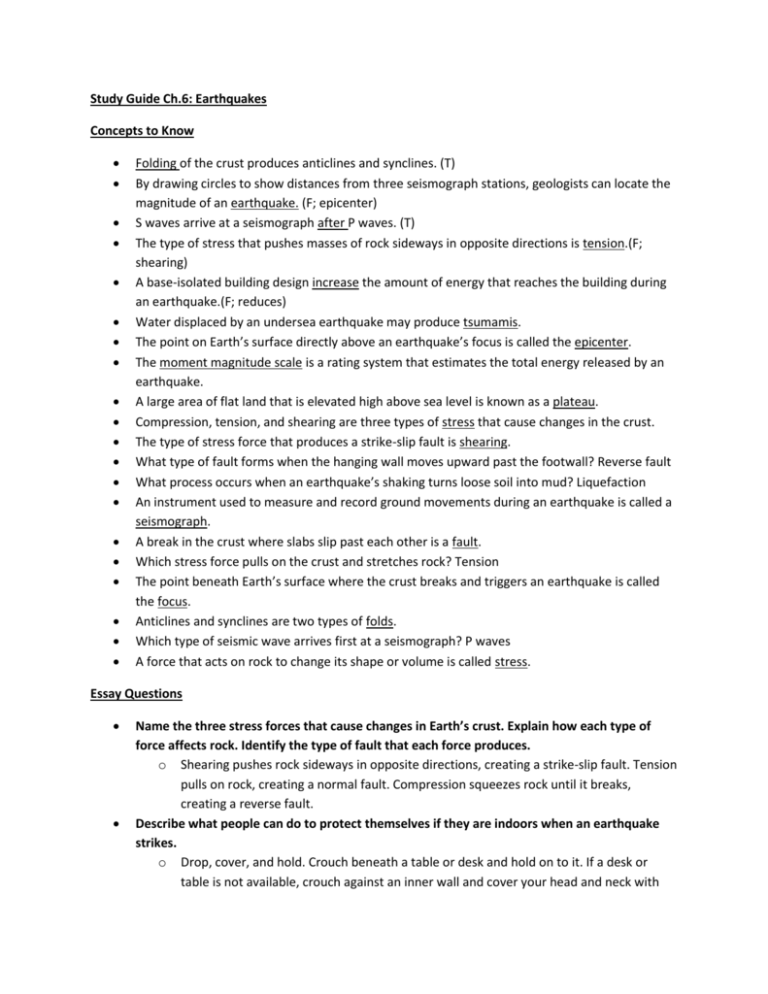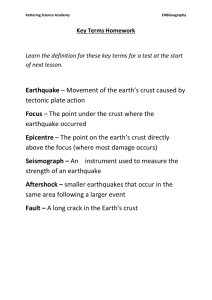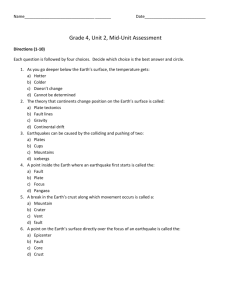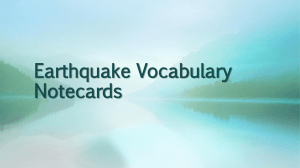Study Guide Ch.6 - Stephanie Dietterle Webpage
advertisement

Study Guide Ch.6: Earthquakes Concepts to Know Folding of the crust produces anticlines and synclines. (T) By drawing circles to show distances from three seismograph stations, geologists can locate the magnitude of an earthquake. (F; epicenter) S waves arrive at a seismograph after P waves. (T) The type of stress that pushes masses of rock sideways in opposite directions is tension.(F; shearing) A base-isolated building design increase the amount of energy that reaches the building during an earthquake.(F; reduces) Water displaced by an undersea earthquake may produce tsumamis. The point on Earth’s surface directly above an earthquake’s focus is called the epicenter. The moment magnitude scale is a rating system that estimates the total energy released by an earthquake. A large area of flat land that is elevated high above sea level is known as a plateau. Compression, tension, and shearing are three types of stress that cause changes in the crust. The type of stress force that produces a strike-slip fault is shearing. What type of fault forms when the hanging wall moves upward past the footwall? Reverse fault What process occurs when an earthquake’s shaking turns loose soil into mud? Liquefaction An instrument used to measure and record ground movements during an earthquake is called a seismograph. A break in the crust where slabs slip past each other is a fault. Which stress force pulls on the crust and stretches rock? Tension The point beneath Earth’s surface where the crust breaks and triggers an earthquake is called the focus. Anticlines and synclines are two types of folds. Which type of seismic wave arrives first at a seismograph? P waves A force that acts on rock to change its shape or volume is called stress. Essay Questions Name the three stress forces that cause changes in Earth’s crust. Explain how each type of force affects rock. Identify the type of fault that each force produces. o Shearing pushes rock sideways in opposite directions, creating a strike-slip fault. Tension pulls on rock, creating a normal fault. Compression squeezes rock until it breaks, creating a reverse fault. Describe what people can do to protect themselves if they are indoors when an earthquake strikes. o Drop, cover, and hold. Crouch beneath a table or desk and hold on to it. If a desk or table is not available, crouch against an inner wall and cover your head and neck with your arms. Avoid the outer walls of a building, as well as windows, mirrors, wall hangings, and furniture that might topple. Describe the differences between the Mercalli scale, the Richter scale, and the moment magnitude scale. o The Mercalli scale rates earthquakes based on the intensity of their effects on buildings and the land at a particular location. The Richter scale rates earthquakes based on the size of their seismic waves as measured by seismograph. The moment magnitude scale rates earthquakes by estimating the total energy they release based on seismographic data and measurements of fault movements. Name four instruments that geologists use to monitor movements along faults, and explain how each instrument works. o A creep meter uses a wire stretched across a fault to measure horizontal movement of the ground. A laser-ranging device bounces a laser beam off the ground to detect slight fault movements. A tiltmeter measures the depth of liquid in two connected bulbs to detect tilting of the ground. GPS uses a network of Earth-orbiting satellites to measure tiny movements of markers set up on the opposite sides of a fault. Why is it so difficult for geologists to predict earthquakes? o Geologist can monitor movements of the land surface but not movements deep below ground, where earthquakes occur. Geologists hypothesize but do not know for certain that slight movements on the surface signal an impending earthquake. Even if such surface movements are reliable signals, geologists have no way of knowing how soon the earthquake may strike.









